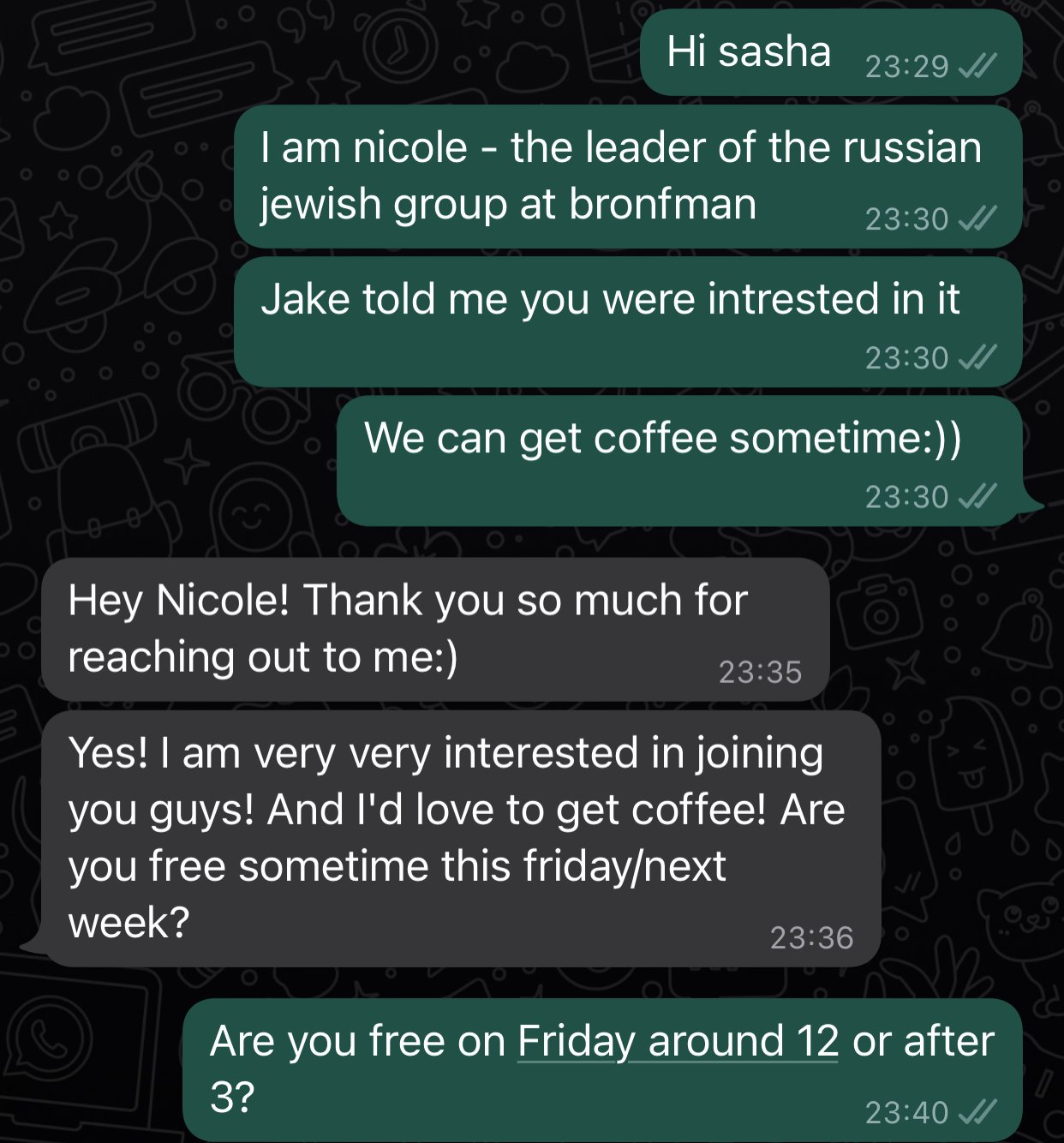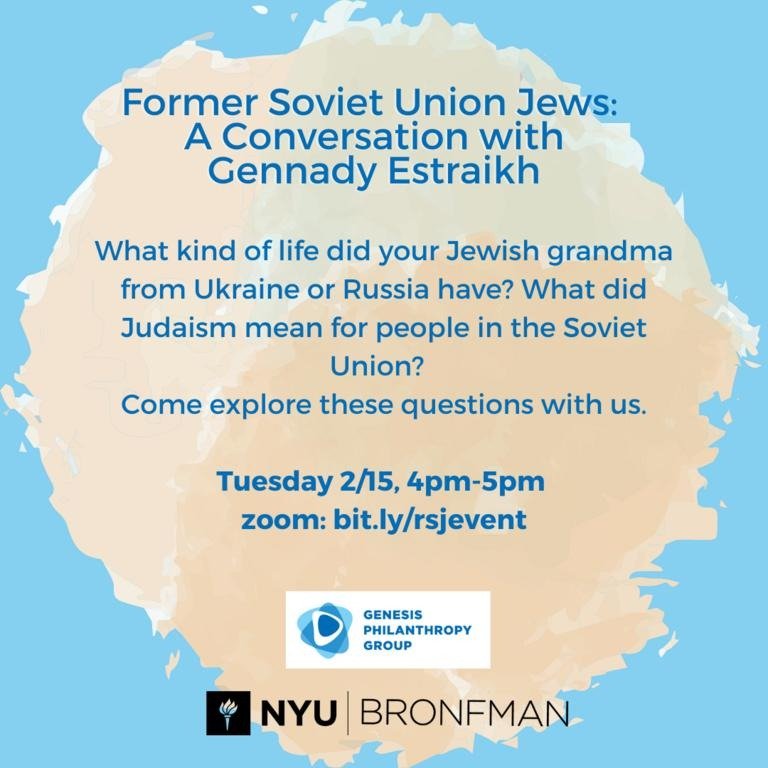Community Building Initiative
Establishing a community for Russian-speaking Jewish students for the NYU Bronfman Center for Jewish Student Life
Sponsored by Genesis Philanthropy Group
The Challenge.
NYU has a vast Jewish student population with people of diverse backgrounds. While there are many sub-communities for religious and identity groups, I noticed that there was not a cultural group that encompassed my identity – a Jewish student with parents from the Former Soviet Union (FSU). Coming back to in-person student life after the Covid-19 lockdown, I recognised the demand for this community.
My goal was to establish this niche community for the Russian Speaking Jewish (RSJ) identity.
The Solution.
I established a community of Russian-speaking Jews on campus through a group chat, event planning, creating a presence in the community.
The Role.
Founder and leader of the project on behalf of the Russian-speaking Jewish Community.
Solution








Interventions
Presence as a Leader
I talked to over 70 Jewish students one-on-one, becoming the face as the leader of the RSJ community.
My presence also enabled the wider Jewish community to refer RSJ to me upon meeting them.
Group chat
I added everyone to one group chat on Whatsapp where students were able to communicate meet ups, share projects they worked on, relate over common identity. It grew to 38 participants within a year.
Events
I planned 5 events throughout the year, 10 group meet ups.
Events included a talk by historian, volunteer activity, shabbat dinner with food from Former Soviet Union countries.
Impact of Solutions
Those three interventions a create successful student experiences by crafting events that created a sense of belonging.
Brought culturally similar people together who would not otherwise know other Russian Jews on campus
Students were engaged in conversations about Judaism and their post-Soviet Union heritage
People felt seen and understood with their unique identities
Helped students find their own identity through others
The Process
-
Discover.
• Network & Stakeholder mapping
• In-depth Interviews
-
Define.
• User Persona
-
Develop.
• Brainstorming ideas
• Journey Mapping
-
Deliver.
• Building the solution
Discover.
Generative Research.
I started by using a range of communication channels to find Russian speaking Jewish (RSJ) students who are children of immigrants. I established a presence as the leader of this community in the Jewish Center on campus through my role as a Bronfman Center Engagement Intern (BCEI).
Stakeholder Mapping
To get a better understanding of the stakeholders of establishing this service, I created a stakeholder map showing all the people and organisations involved in the process. I mapped out their relationship to each other and the overall community to understand how to prioritise my communication and outreach efforts.
Network mapping
I created a network of people in my network to reach out to and identify how I could find people to build a community with.
In-depth Interviews
This enabled me to get funding for coffee chats with students. This enabled me to conduct one-on-one in-depth interviews of the students. Over two semesters, I talked with over 70 students. During those conversations I asked students about:
Their academic background (year, major, career interests)
Their cultural and ethnic background (relationship to Russian speaking or Former Soviet countries)
Their relationship to Judaism and the Jewish community
Grasp of their social network
Their interest in a Russian-Speaking Jewish community
The interviews not only allowed me to get an in-depth understanding of the students, but it also gave them a go-to person for any questions regarding the wider Jewish community.
Insights from Interview
Students communicated that they could not relate to the experience of other Jewish students due to their background, however, still felt that Judaism was a big part of their identity.
Jewish students feel disconnected to the wider Jewish community as they view Judaism as more of an ethnic and cultural group. Most students did not practice religion at home
I found patterns of similarities and significant differences among the RSJ students which I will take into account when building the community
Define.
User Persona
Through the conversations with the students, I was able to create a persona of the typical student who became a part of the RSJ community.
Develop.
Brainstorming
Now that I knew my audience, I brainstormed how I could make this community happen.
Journey Mapping
I created a multi-scenario journey map to gain understanding of the different avenues that students joined the Russian-Jewish Speaking community. This helped me gain an understanding of the opportunities for improvement as well as for future leaders to organise the service and marketing strategies.
Deliver.
Building the solution
As a student leader at Bronfman, I was able to participate in development training that helped and guided me on engaging people and creating a network.
Throughout my process of event planning, I would reflect and review the learning moments with my supervisor to ensure that I am succeeding in my goals.
You can see the final solution above on this page.
Personal Reflection
What I enjoyed the most was to see the community grow throughout the year and make an impact on personal people’s lives. I enjoyed communicating with such a vast number of students about their experiences and lives and guide them through the year.
One big take away was to balance active listening with story telling when supporting people. I became more aware of my surroundings and creating harmony in a space. I also learned the importance communication strategies and planning. I communicated with management, funders, groups and individual students, both online and in-person.
One unexpected challenge was making sure that I was not projecting Eurocentric bias onto the community. I learned that the community of Former Soviet Union Jewish students spanned over a large geographical and cultural area so it was interesting to find common grounds and differences within the community.






